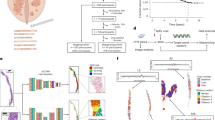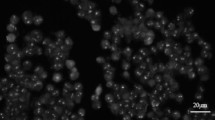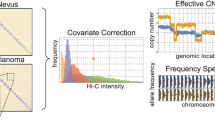Abstract
We report an innovative fluorescence in situ hybridization technique which exploits a unique resource of 41 telomere-specific probes and allows the simultaneous analysis of the subtelomeric region of every chromosome for deletion, triplication and balanced translocation events. This technique requires only a single microscope slide per patient and is expected to be a useful diagnostic tool with applications in the fields of idiopathic mental retardation, the detection of congenital abnormalities and in some forms of cancer. This will lead to more accurate genetic counselling of patients and their families and will provide the basis for future diagnostic, therapeutic and preventative measures.
Similar content being viewed by others
Log in or create a free account to read this content
Gain free access to this article, as well as selected content from this journal and more on nature.com
or
References
Lichter P, Cremer T, Tang C-JC, Watkins PC, Manuelidis L, Ward DC: Rapid detection of human chromosome 21 aberrations by in situ hybridization. Proc Natl Acad Sci USA 1988; 85:9138–9142.
Pinkel D, Landegent J, Collins C, Fuscoe J, Segraves R, Lucas J, Gray J: Fluorescence in situ hybridization with human chromosome-specific libraries: Detection of trisomy 21 and translocations of chromosome 4. Proc Natl Acad Sci USA 1988;85:9664–9668.
Collins C, Kuo WL, Segraves R, Fuscoe J, Pinkel D, Gray JW: Construction and characterization of plasmid libraries enriched in sequences from single human chromosomes. Genomics 1991; 11:997–1006.
Schröck E, du Manoir S, Veldman T, Schoell B, Wienberg J, Ferguson-Smith MA, Ning Y, Ledbetter DH, Bar-Am I, Soenksen D, Garini Y, Ried T: Multicolor spectral karyotyping of human chromosomes. Science 1996;273:494–497.
Speicher MR, Ballard SG, Ward DC: Karyotyping human chromosomes by combinatorial multifluor FISH. Nat Genet 1996;12:368–375.
Flint J, Wilkie AOM, Buckle VJ, Winter RM, Holland AJ, McDermid HE: The detection of subtelomeric chromosomal rearrangements in idiopathic mental retardation. Nat Genet 1995;9:132–139.
Giraudeau F, Aubert D, Young I, Horsley SW, Knight SJL, Kearney L, Vergnaud G, Flint J: Molecular-cytogenetic detection of a deletion of 1p36.3. J Med Genet 1997, in press.
National Institutes of Health and Institute of Molecular Medicine Collaboration: A complete set of human telomeric probes and their clinical application. Nat Genet 1996;14:86–89.
Sambrook J, Fritsch EF, Maniatis T: Molecular Cloning: A Laboratory Manual. Cold Spring Harbor/NY, Cold Spring Harbor University Press, 1989.
Buckle VJ, Rack K: Fluorescent in situ hybridization; in Davies KE (ed): Human Genetic Diseases: A Practical Approach. Oxford, IRL Press, 1993, pp 59–80.
Larin Z, Fricker MD, Maher E, Ishikawa-Brush Y, Southern EM: Fluorescence in situ hybridisation of multiple probes on a single microscope slide. Nucleic Acids Res 1994;22: 3689–3692.
Maher EJ, Larin Z, Smith S, Cardy DLN, Southern EM: Fluorescence in situ hybridisation of twenty-four different chromosome-specific paints on a single microscope slide; in The Association of Clinical Cytogeneticists Programme and Abstract Booklet, April 1995.
Youngman S, Bates GP, Williams S, McClatchey AI, Baxendale S, Sedlacek Z, Altherr M, Wasmuth JJ, MacDonald ME, Gusella JF et al: The telomeric 60 kb of chromosome arm 4p is homologous to telomeric regions on 13p, 15p, 21p, and 22p. Genomics 1992;14:350–356.
Wright TJ, Wijmenga C, Clark LN, Frants RR, Williamson R, Hewitt JE: Fine mapping of the FSHD gene region orientates the rearranged fragment detected by the probe p13E-11. Hum Mol Genet 1993;2:1673–1678.
Nesslinger NJ, Gorski JL, Kurczynski TW, Shapira SK, Siegal-Bartelt J, Dumanski JP, Cullen RF Jr, French BN, McDermid HE: Clinical, cytogenetic and molecular characterisation of seven patients with deletions of chromosome 22q13.3. Am J Hum Genet 1994;54: 464–472.
Cooke HJ, Brown WR, Rappold GA: Hypervariable telomeric sequences from the human sex chromosomes are pseudoautosomal. Nature 1985;317:687–692.
Kvaloy K, Galvagni F, Brown WR: The sequence organization of the long arm pseudoautosomal region of the human sex chromosomes. Hum Mol Genet 1994;3:771–778.
Acknowledgements
We would like to acknowledge The Wellcome Trust (S.J.L.K., R.R. and J.F.), the Medical Research Council (L.K.) and Action Research (S.W.H.) for financial support. Dr. David Ledbetter is thanked for his assistance. The Multiprobe device is protected by Registered Design No. 2050801.
Author information
Authors and Affiliations
Corresponding author
Rights and permissions
About this article
Cite this article
Knight, S.J.L., Horsley, S.W., Regan, R. et al. Development and Clinical Application of an Innovative Fluorescence in situ Hybridization Technique Which Detects Submicroscopic Rearrangements Involving Telomeres. Eur J Hum Genet 5, 1–8 (1997). https://doi.org/10.1007/BF03405870
Received:
Revised:
Issue date:
DOI: https://doi.org/10.1007/BF03405870



